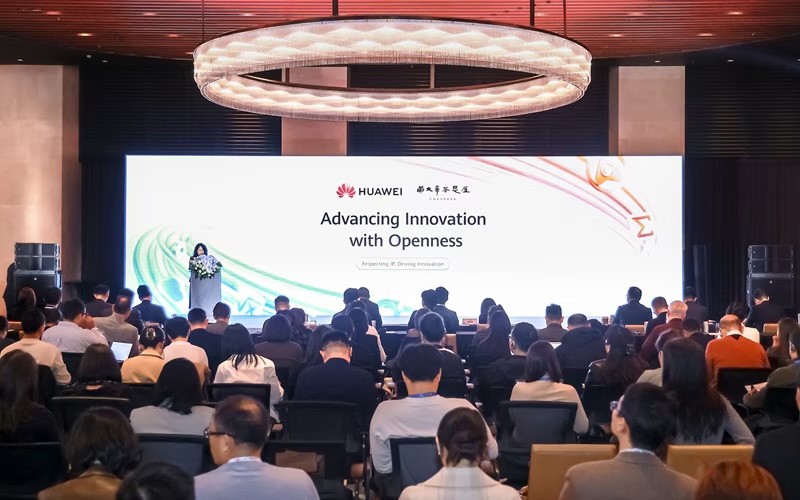As the global race for technological leadership intensifies, Huawei is reinforcing its belief that innovation thrives through openness and strong governance. At its sixth Innovation and Intellectual Property (IP) Forum, themed “Advancing Innovation with Openness,” the company brought together global experts, policymakers, and industry leaders to explore how open collaboration and IP protection can power scientific and social progress. The forum, held in Beijing, featured the announcement of Huawei’s biennial Top Ten Inventions award, unveiling new milestones in research, patenting, and open-source cooperation — a clear reflection of Huawei’s long-term vision of an inclusive innovation ecosystem that bridges science, technology, and market needs.
Innovation as a Core Value
“Innovation drives society and technology forward, and it’s in our DNA,” said Liuping Song, Huawei’s Chief Legal Officer. “We are committed to an open approach to innovation. Huawei respects the IP of others and protects its own, including patents, trademarks, copyrights, and trade secrets.” This commitment is underpinned by sustained R&D investment. In 2024, Huawei invested CNY179.7 billion in R&D, representing 20.8% of total revenue. Over the past decade, cumulative R&D investment has reached CNY1.249 trillion, making Huawei the sixth largest global investor in R&D for eight consecutive years, according to the EU Industrial R&D Investment Scoreboard. Huawei’s innovation philosophy rests on two pillars: advancing science and technology while responding to customer needs. The company “takes business value and market requirements as the orientation to guide investment in science and technology,” while stimulating demand through technological breakthroughs that create shared value.
A History Built on Patents and Perseverance
Huawei’s journey in intellectual property began in 1995 with its first Chinese patent filing, followed by its first U.S. and European patents in 1999 and 2001. By 2008, Huawei ranked first globally under the Patent Cooperation Treaty (PCT) with 1,737 published applications, marking its rise as a global innovation powerhouse. Marco Alemán, Assistant Director General of the World Intellectual Property Organization (WIPO), stated: “Huawei is a leading global user of WIPO’s Global IP Services and a strong driver of innovation. Huawei had 6,600 published PCT applications in 2024 and has been the top user of the PCT system since 2014.” Today, Huawei holds more than 150,000 active patents worldwide, including over 50,000 in China, 29,000 in the United States, and 19,000 in Europe. Over the past three years, the company has signed or renewed cross-licensing agreements with major international firms such as Nokia, Ericsson, Amazon, Samsung, and Sharp, reinforcing what it calls a “positive cycle of investment, return, and reinvestment.”
Recognizing the Power of Ideas: The ‘Top Ten Inventions’
Since 2015, Huawei’s Top Ten Inventions award has recognized technologies that define new product series, enable key commercial features, and deliver significant business and social value. At this year’s forum, the winning innovations spanned fields such as computing, the HarmonyOS operating system, and storage technologies. These inventions reflect Huawei’s commitment to combining fundamental research with practical applications — from next-generation connectivity and AI to open digital ecosystems that empower developers and partners globally.
Driving Open Standards and Open Source
For Huawei, openness is both a philosophy and a strategy. “Open standards are conducive to industry development,” the company noted. In 2024 alone, Huawei made over 10,000 technical contributions to global standardization organizations, bringing its total to more than 140,000. Alan Fan, Vice President and Head of Huawei’s Intellectual Property Rights Department, emphasized: “As a leading contributor to technology in the ICT sector, Huawei shares its technologies through open-source software, open hardware, patent filings, standard contributions, and academic papers.” In 2024, Huawei published 37,000 patents, 1,000 academic papers, and contributed to major open-source communities such as openEuler and OpenHarmony. By the end of 2024, openEuler had surpassed 10 million installations, with 1,956 partners and over 21,000 developers, making it one of the world’s largest open-source operating system communities. Meanwhile, OpenHarmony 6.0, released in September 2025, now powers over one billion devices worldwide. “Open collaboration accelerates software innovation and ecosystem prosperity,” Fan said.
A Global IP Footprint
By the end of 2024, Huawei’s patents underpinned 2.7 billion 5G devices, 1.2 billion Wi-Fi products, and 3.2 billion multimedia devices worldwide, with 48 Fortune Global 500 companies licensed under its portfolio. The company’s patent licensing revenue reached approximately US$630 million in 2024, while total royalties paid throughout its history are “nearly three times the amount received,” according to Song. This balanced approach reflects Huawei’s adherence to FRAND (Fair, Reasonable, and Non-Discriminatory) principles. “Huawei is both a licensor and a licensee,” the company explains. “Where we contribute more to a technology, we receive net revenue; where we benefit more, we pay royalties. We advocate a balanced IPR policy widely endorsed by the industry.”
Building an Ecosystem of Shared Growth
Forum speakers emphasized cooperation as the foundation of sustainable innovation. Etienne Sanz de Acedo, CEO of the International Trademark Association, noted: “As an intangible asset, IP is a universal language that translates innovation and creativity into quantifiable value.” Ningling Wang, President-elect of the Licensing Executives Society International, added: “I encourage industry leaders, policymakers, researchers, and entrepreneurs to foster collaboration, share knowledge, reduce barriers, and practice responsible licensing.” Heiwai Tang, Associate Vice-President of the University of Hong Kong, said: “Innovation is a core driver of modern economic growth, and its sustained operation relies upon a robust, open, and globally trusted patent system.” He commended Huawei for “adhering to international IP norms, maximizing the value of IP, and fostering a healthy business ecosystem.”
Innovation Platforms for the Next Generation
To democratize access to knowledge, Huawei launched the Chaspark Patent platform in June 2024, offering free, AI-driven patent search services to researchers and students globally. At the forum, Huawei announced new semantic search and AI summary features, further enabling academic and industry innovators to explore patents efficiently. Speakers, including Yali Zhu (PatSnap China), Qi Wang (Clarivate Asia-Pacific), Mattia Fogliacco (Sisvel), and Laurie Fitzgerald (Avanci Vehicle) shared their perspectives on advancing open innovation.
IP, Governance, and ESG: A Unified Philosophy
Beyond technology, Huawei’s approach to intellectual property is deeply connected to its corporate governance and ESG principles — particularly the “G” pillar. The company views intellectual property as both a business asset and a governance mechanism that safeguards transparency, accountability, and long-term value creation. Huawei’s governance system is built on collective leadership, checks and balances, and customer-centric decision-making, ensuring that authority serves purpose rather than power. This structure reflects the company’s belief that innovation must operate within a framework of ethical governance and responsible oversight. Huawei’s corporate governance model integrates IP management into its broader sustainability strategy, aligning with the company’s S.H.A.R.E. concept — which stands for digital inclusion, security and trustworthiness, environmental protection, and a healthy and harmonious ecosystem. Within this framework, Huawei’s IP portfolio underpins sustainable innovation by protecting trust, enabling fair access to technology, and reinforcing a culture of openness and integrity. The company’s governance philosophy — “staying customer-centric and creating value for customers” — ensures that its technological leadership is exercised with accountability. By embedding IP strategy into governance, Huawei demonstrates how innovation, transparency, and sustainability can coexist — turning intellectual property into a cornerstone of corporate ethics and social responsibility.
Respect, Protection, and Progress
Respecting intellectual property — both one’s own and others’ — remains central to Huawei’s innovation model. The company explicitly prohibits employees from improperly acquiring or disclosing trade secrets, maintaining strict compliance systems to protect sensitive information. “Protecting IP doesn’t mean closing doors; it means building trust,” Song said. “We are committed to creating an environment that safeguards innovation and promotes constructive IP protection. This way, members of the industry can continue to grow and develop together.”
A Vision Rooted in Openness
From its first patent three decades ago to its current leadership in 5G, cloud, and open-source ecosystems, Huawei’s innovation journey reflects a long-term bet on openness as a catalyst for progress. In a rapidly transforming digital landscape — where AI, connectivity, and sustainability intersect — Huawei’s message resonates with clarity: innovation flourishes not in isolation, but through collaboration, governance, and shared responsibility.




